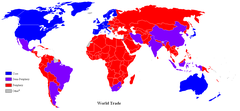Ap Human Geography Unit 6 Test Questions – Flashcards
Unlock all answers in this set
Unlock answersquestion
Agricultural labor force
answer
Most of the agricultural labor force is based in developing countries, about 2% of labor force is agriculture in developed countries
question
Calorie consumption

answer
The average calorie consumption is 1,800 calories
question
Core-periphery model

answer
A model of an economic system in which there is a defined core/periphery region
question
Cultural convergence
answer
Tendency of cultures to become more alike as they communicate
question
Dependency theory
answer
The idea that the relations with countries has an effect on the development of regions
question
Development

answer
Improvement in the material condition of people thru diffusion
question
Energy consumption
answer
The US consumers more than twice as much as developing countries
question
Foreign direct investment
answer
total overseas investment made by private countries
question
Gender
answer
social differences between men and women
question
Gross domestic product (GDP)
answer
estimate of total value of all materials, etc. produced in a year
question
Gross national product (GNP)
answer
total value of all goods produced by a country
question
Human development index

answer
indicator of development of a country made by the UN
question
Levels of development
answer
theory that all countries can reach the same level of development
question
Measures of development

answer
GDP, literacy rate, life expectancy, mortality rate, etc.
question
Neocolonialism
answer
seeking out of the regional culture in uncertainty of the modern world
question
Physical quality of life index

answer
measurement of the quality of life in a country using a number of factors
question
Purchasing power parity

answer
measurement of what money buys in a country
question
Rostow, W. W.
answer
proposed a model for economic development in 1960, "stages of growth model"
question
"Stages of growth" model

answer
model where economic development is split up into stages; 1. Traditional society 2. Preconditions for Take-Off 3. Take-Off 4. Drive to maturity 5. High mass consumption
question
Technology gap

answer
contrast between available technology between developed core regions and developing periphery regions
question
Technology transfer
answer
diffusion of technology, usually from more developed areas
question
Third world

answer
countries considered not fully developed or undeveloped in economic and social terms
question
World systems theory
answer
economic activities in the developed world are linked to the social change in developing world
question
Gender inequality index
answer
measurement of a country's equality between men and women
question
Acid rain

answer
created when sulfur and nitrogen change chemically as they dissolve into water vapor
question
Agglomeration
answer
spatial grouping of activities for mutual benefit
question
Agglomeration economies
answer
savings of an individual enterprise from a local association
question
Air pollution
answer
pollution of earth's atmosphere from fossil fuels and other gases produced
question
Aluminum industry
answer
massive charges of electricity needed to extract aluminum, located in Canada and Eastern Siberia
question
Assembly line production

answer
arrangement of workers and machines that create a product as it goes down a line
question
Bid rent theory

answer
land users are prepared to pay different amounts for the bid rent based on the location of the city
question
Break-of-bulk point
answer
location where transfer is possible from one point to another
question
Canadian industrial heartland
answer
St. Lawrence Valley, central of Canadian market and access to hydroelectric power
question
Carrier efficiency
answer
ratio of output to input for a given carrier
question
Comparative advantage

answer
an area produces the items for which it has the greatest ratio for advantage compared to other areas
question
Cumulative causation

answer
tendencies for economic growth are self-reinforcing
question
Deglomeration
answer
location of industrial or other activities away from agglomaerations
question
Deindustrialization

answer
decline in manufacturing to a national economy
question
Economic sectors
answer
primary sector, secondary sector, tertiary sector, quaternary sector, quinary sector
question
Economies of scale

answer
cost advantages to manufactures that come from high production
question
Ecotourism
answer
travel that doesn't harm ecosystems or people
question
Energy resources

answer
Renewable: hydropower, biomass, wind, solar, geothermal, biofuels Non-renewable: coal, oil, natural gas, nuclear
question
Entrepot
answer
trading center where merchandise can be imported or exported without paying duties
question
Exporting processing zone
answer
EPZ; areas made by countries that have export-oriented production
question
Fixed costs

answer
a cost that must be met without the level of output
question
Footloose industry
answer
an industry that shows no specific orientation to the market or materials
question
Four tigers
answer
the economies of South Korea, Hong Kong, Taiwan, and Singapore
question
Greenhouse effect

answer
increase in earth's temperature caused by carbon dioxide trapping radiation
question
Growth poles
answer
economic activities that are near high-growing industries
question
Heartland/rimland

answer
any power in Eurasia can dominate the world
question
Industrial location theory

answer
explaining and predicting where industries will be located based on cost, transportation, labor, etc.
question
Industrial regions

answer
Eastern North America, Northwestern Europe, Eastern Europe, East Asia
question
Industrial revolution
answer
innovations and inventions that led to the use of machines in manufacturing process, 1700s England
question
Industry
answer
segment of an economy concerned with the manufacturing of goods
question
Receding industry
answer
an industry receiving a lower that average growth rate
question
Growing industry
answer
an industry that is receiving a higher than average growth rate
question
Infastructure

answer
the underlying framework of services needed for productive activity
question
International division of labor
answer
the specialization in particular products
question
Labor-intensive

answer
industry in which labor costs represent a large portion of total production
question
Least-cost location
answer
developed by Alfred Weber according to which the location of manufacturing places is determined by labor, transportation, and agglomeration
question
Major manufacturing regions
answer
Eastern Anglo America, Western and Central Europe, Eastern Europe, Eastern Asia
question
Manufacturing exports

answer
a feature where the host country makes areas with favorable tax, regulatory, etc. to attract foreign manufacturing operations
question
Manufacturing/warehouse location
answer
location of a factory
question
Industrial parks
answer
area of land developed as a site for factories and other businesses
question
Agglomeration

answer
spatial grouping of activities for mutual benefit
question
Shared services

answer
any services provided on a regional basis between groups
question
Zoning
answer
area subject to particular planning restrictions
question
Transportaion

answer
cost to and from markets
question
Taxes
answer
taxes imposed on the location of the wharehouse
question
Environmental considerations

answer
how the manufacturing will affect the environment
question
Maquiladora
answer
factories built by U.S. companies in Mexico near the U.S. border to take advantage of much lower labor costs in Mexico
question
Market orientation
answer
tendency for a manufacturer to locate near the market
question
Multiplier effect
answer
when a given change sets in motion a sequence of further industrial advancement
question
NAFTA

answer
North American Free Trade Agreement: launched in 1994, links Canada, US, and Mexico
question
Outscoring

answer
produce abroad parts for domestic use
question
Ozone depletion

answer
protects us from harmful UV rays, CFCs destroy ozone layers
question
Plant Location

answer
location of a plant relative to the market and it's supplies
question
Supplies
answer
materials needed to produce a good
question
"Just in time"

answer
seeks to reduce inventory costs by delivering products at the exact minute and producing products at short notice
question
Delivery

answer
taking a product from the manufacturer to the consumer
question
Post-industrial

answer
stage in economic development in which service activities become more important than goods production
question
Refridgeration

answer
cold temperature used in preserving a perishable good or product during delivery
question
Resource crisis

answer
future shortages of non-renewable energy sources with increased demand
question
Resource orientation

answer
tendency for a market to orientate itself near it's resources
question
Special economic zones (China)

answer
includes Pudong District, Xiamen, Shantou, Shenzhen, Zhuhai, and the Hainan Province (all of these are coastal areas providing vital economic advantages for the country of China)
question
Specialized economic zones

answer
region with economic laws that are more liberal than the country's typical economic laws
question
Substitution principle
answer
substitution of a product, service or process to another that is more efficient and beneficial
question
Threshold/range

answer
market area of service
question
Time-space compression
answer
overcoming barriers using technology and communcation
question
Trade (complementarity)

answer
exchange between two or more parties
question
Transnational corporation
answer
companies that have international production and other affiliations
question
Variable costs

answer
cost of enterprise operation that varies either by output level or by location of the activity
question
Weber, Alfred
answer
devised a model of how to understand industrial locations in regard to several factors, including labor supply, markets, resource location, and transpiration
question
Weight-gaining

answer
a product that during manufacturing gains weight
question
Weight-losing
answer
a product that during manufacturing loses weight
question
World cities
answer
cities that directly and significantly effect global affairs through socio-economic means, culture, and politics



